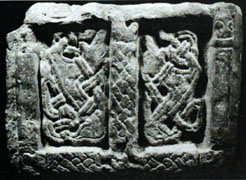Select a site alphabetically from the choices shown in the box below. Alternatively, browse sculptural examples using the Forward/Back buttons.
Chapters for this volume, along with copies of original in-text images, are available here.
Object type: Part of grave-cover
Measurements: H. 42.8 cm (16.9 in); W. 59.5 cm (23.4 in); D. 21.8 cm (8.6 in)
Stone type: Fine-grained, dolomitic, white to very pale brown (10YR 8/2–8/3) limestone, with small cavities; Lower Magnesian Limestone, Upper Permian; reused Roman ashlar, from Tadcaster area (see Fig. 5)
Plate numbers in printed volume: 328, 331-332
Corpus volume reference: Vol 3 p. 102-103
(There may be more views or larger images available for this item. Click on the thumbnail image to view.)
Only the upper surface carries ornament.
The raised edge moulding is set in from the edge of the long sides. It is flat and broad, and extends across the top of the slab where it appears to be supported by animal head terminals facing down the monument. Their eyes are incised and a bar, perhaps a muzzle, crosses just below them. Within is a superimposed cross, type A12, decorated with closely woven four-strand plain plait, with breaks. There was a circular boss at the centre. At the end of the upper arm is an inward facing animal mask, with gaping jaws and elliptical eyes, in line with those on the flanking borders, but not separated from the interlace (contra Collingwood 1909, fig. on 190). The terminal heads to the lateral arms are shown in profile and overlap the border moulding; they face outwards. The left-hand one has a hawk-like beak and an elliptical eye. The other has grinning closed jaws with pricked 'teeth' in the slit.
Two panels survive above the cross-arms, deeply recessed. Each contains a profile beast, crouching and fettered by its own body extensions formed from median-incised strands. They are solitary within the panel. They have incised elliptical eyes and a three-toed fore paw. The snout has nose-folds. The animal on the left has more complex fettering than that on the right. The latter's tail or hind leg is joined to the ear lappet and a loose strand with a ring helps to convey complexity.
The total surface is covered by white gesso. There are remains of fix-points, and shrinkage holes in the gesso appear over them.
This piece is the work of the York Master. Whilst the organization of the design is similar to the York Metropolitan School slab series, the deep cutting and flat relief style are like those of the Newgate shaft (Ills. 342–6). The inclined cutting adjacent to crossing strands is a diagnostic feature of the York Master's work (see Chap. 10; Coppergate 2; and Newgate 1, 5). Alignment of the visible fix-points shows that the whole design was planned on a fine diagonal grid. The sense of space behind solitary animals in each panel is reminiscent of the usage on the Hickling hogback, Nottinghamshire (Lang 1984a, 140–1).



